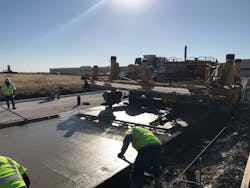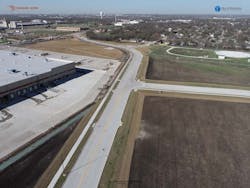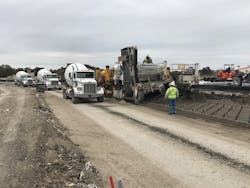Using Digital Construction Management Solutions for Elm Street Project in McKinney, Texas
From its humble beginnings in 1963 with a $20,000 loan and a desire to deliver quality construction on alley and small street rehabilitations in Dallas, Texas, Ed Bell Construction has grown to a more than $100M company—in large part because of its commitment to staying on the leading edge of technology.
Today, Ed Bell Construction offers a wide variety of solutions tailored to the heavy/highway and municipal reconstruction markets, including bridge structures, earthwork and grading, concrete paving, demolition, removals, and much more.
Automating Estimating and Bidding
Over the last 30 years, Ed Bell Construction has constructed more than 200 projects worth over $1 billion for the Texas Department of Transportation (TxDOT), and another 150 for various municipalities. TxDOT does a monthly letting to release all new jobs, which is typical for the department. TxDOT’s Contractors Desktop Application (CDA) allows companies to import all bid items for a project as well as electronically submit proposals.
Elm Street Project, McKinney, Texas
Recently, the company secured a contract and delivered a job for Hill & Wilkinson General Contractors of Dallas for expansion of Encore Wire’s headquarters located on the northwest corner of Airport Drive and Elm Street. The job was unusual because the company typically does public work, but this was a private contract, working with Hill & Wilkinson (H&W). It was a $10 million project that Ed Bell Construction thought was to take 14 months, but H&W required it sooner, so it was delivered in nine months. “Our team has never worked so hard in their life, but we got the job done on time and in our budget,” said Phillippe Falkner, Business Services Specialist and Project Manager of Ed Bell Construction.
The roadway improvements for the project included:
- Realign Elm Street to the north and abandon the existing connection to Airport Drive for the expansion of Encore Wire’s campus.
- Connect Gerrish Street and Bumpas Street to the new Elm Street alignment to improve access on the east side of the neighborhood.
Encore Wire requested the abandonment of the portion of Elm Street that separates property they own north of Elm Street and their existing campus. The McKinney City Council approved the abandonment request based on the condition that the new section of Elm Street be completed before the abandonment occurred.
The project began in June of 2020. The road was opened in March 2021 and completed in May 2021. What was originally contemplated to be 14 months of construction to get traffic moved was completed in nine months.
This project realigned Elm Street to a new right-of-way location to incorporate the existing Elm Street into the Encore Wire campus after completion of their new service center complex. The project required 28,000 SY of concrete paving, 6,100 LF of storm drainpipe with over 100 drainage structures, almost a mile of 12-in. and 8-in. water and sewer, illumination, new diversion channels, and casing / cellular grouting of over 300 LF of high-pressure water transmission line.
The road work will improve response time for emergency responders by providing a more direct access to the neighborhood. These upgrades will also improve traffic circulation for the neighborhood by providing additional connections along Elm Street.
Project Challenges
Ed Bell Construction dealt with several challenges during the project. These included several redesign change orders and challenges coordinating multiple owners (Hill & Wilkinson as General Contractor, Encore Wire as the owner, City of McKinney as governing inspection body, North Texas Municipal Water District, etc.). The schedule was driven by completion of the service center complex, which was continuously the focus of acceleration by the owner.
The roadway had to be built while the service center was being built so that the road could tie into the facility upon completion. Ed Bell Construction had to make sure all the utility work was completed before the roadway could begin. As design changes kept moving up the project timeline, Ed Bell had to make sure their project steps were moved up as well, which involved communicating with the utilities and others.
Managing Change Orders
Ed Bell Construction used HCSS Plans to keep up with the multitude of changes that came with the project. The software helped to reduce the cost incurred from rework caused by delays in moving updates to paper-based plans in the field. HCSS Plans is a digital plan management solution, the development of which was pioneered by the Ed Bell Construction Company.
The company worked closely with HCSS prior to the project to create Plans because, “We needed to find a faster and more efficient way to get plan revisions out to our foremen in the field because we wanted to reduce the cost of rework related to out‐of‐date plans,” Falkner added.
Reducing paper plans has reduced rework because of out-of-date plans in the field. With its old paper-based system, change orders and revised sheets—often delivered at the last minute by owners—could take too long to make its way through vetting and engineer review and out to the field. Sometimes the work had already been done.
Digging into the numbers from before it implemented any digital tools, Falkner determined the company was spending between $100,000 to $125,000 per year on rework. “For a $100 million company, that translates into wasting about 0.1% of your profit,” Falkner said. “Anybody in the highway and heavy civil industry will tell you margins are thin. We make our money based on sheer volume. You can’t afford to be giving away one‐tenth or two‐tenths of a percent on preventable errors.”
Going paperless did the trick for staying on top of the critically important task of managing plan revisions. As a result, the company had no cost expenses due to rework from plans not being updated. This was especially important because as the owner changed timelines, every company involved in the build had to be alerted to changes.
When a change in the plans was made, the foremen could precisely see the exact changes that the updated plans included. They could overlay two versions of the plan to compare the revision. As soon as the project was complete, Ed Bell Construction could easily produce precise as‐built plans with HCSS Plans.
Working with Multiple Entities
It was a challenge for the general contractor and Ed Bell Construction to keep on top of all the multiple governing bodies’ directions. HCSS HeavyJob was used to manage the project to ensure there was accurate job costing to help the project stay on time and on budget. HeavyJob manages time cards, job costs, and project management for the company. Contractors can enter time cards while in the field to reduce paperwork and payroll errors. Crew times are automatically submitted via mobile devices.
Because this project had so many subcontractors and Ed Bell acted as a subcontractor to Hill & Wilkinson, HeavyJob made it easier to track, reconcile, and report materials, costs, and subcontractor performance. Invoices or payments can be issued immediately. The time card information can be exported to Payroll and Accounting systems to eliminate double entry and prevent errors.
Ed Bell tracked quantities daily to ensure the stricter-than-normal billing requirements were met. They also required more aggressive “work complete” reporting.
Speeding Up the Project to Meet the Deadline
As mentioned, the original timeline for the project was moved up, so Ed Bell Construction had to deploy a few other tools to be able to meet this deadline and speed progress at the site.
A digital dispatching solution was used daily to coordinate the delivery of equipment, internal and third-party trucking, as well as manage forms and small tools assets. Ed Bell was able to reconcile and verify the haul-off material on-site to other contractors at the service center and to the haul-off waste from the site.
A drone belonging to Hill & Wilkinson was used to document progress at the worksite. The location of the project was right next to the McKinney National Airport. Because of this, only one entity could get an FAA waiver to fly in the airspace. “Typically, we do a lot with drones on our projects, but couldn’t here. The drone flights were done monthly or as needed,” Falkner said.


